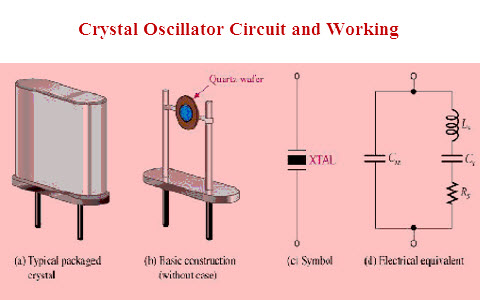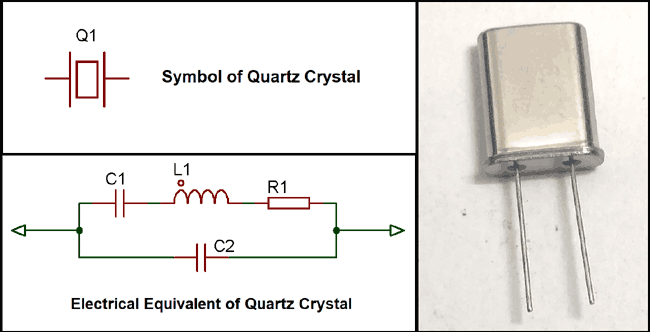Welcome to Linquip again. In this article, we are going to discuss the core difference between oscillator and crystal.
To understand the difference between oscillator and crystal, first, we should know what they are and how they function.
Depending on your requirements, you can find all the information you need about oscillators or crystals on Linquip’s website. At Linquip, we have a team of experts ready to answer any questions you may have regarding the use of these types of devices. Start by reading Linquip’s article, “What Is Electrical?“.
In addition, you can get access to all of Linquip’s services by becoming a Linquip Expert. How about contributing to Linquip through a Guest Post? The Linquip platform enables you to submit your content as a guest.
Oscillator and crystal are two different components that power up the processor in different ways.
The oscillator is a component that provides total connectivity to a processor clock. It has either a plastic or metal exterior and is comprised of four pins that two of these pins serve as conduits for power. The third pin in the oscillator serves as an output, while the last pin is used to accommodate extra mechanical connection. The oscillator is configured with a buffer, which means it is capable of high output drive tasks.
The core difference between oscillator and crystal is that the crystal is not as multi-featured as the oscillator, simply because it is one of the many things that make up an oscillator. The crystal forms the oscillator along with other parts such as the trim caps, inverting amplifier, and proper output buffer. Furthermore, crystals need to be calibrated in order to fit into an oscillator configuration. Details such as loading parameters and resonant cut types need to be finalized before inserting the crystal into the oscillator.
Oscillator vs. Crystal
Electrical engineers and hardware specialists must know how to define and differentiate between oscillators and crystals. However, if you’re not familiar with the industrial field, these terms may be confusing for you. The oscillator and the crystal are utilized in processors and other electrical devices. You can find these components in laptops, gaming consoles, cellular phones, the Central Processing Unit (CPU) of desktop computers, and other complex electrical gadgets. Both the oscillator and the crystal allow a processor to work.
Now, to understand the major difference between oscillator and crystal, we’re going to look into each of these components and explain how they function:
What’s an oscillator?
An oscillator is a circuit that produces a continuous, repeated, alternating waveform without any input. Oscillators convert unidirectional current flow from a DC source into an alternating waveform which is of the desired frequency, as decided by its circuit components.
Oscillators can be classified into various types depending on the parameter considered i.e. based on the feedback mechanism, the shape of the output waveform, etc. These classification types have been given below:
- Classification Based on the Feedback Mechanism: Positive Feedback Oscillators and Negative Feedback Oscillators.
- Classification Based on the Shape of the Output Waveform: Sine Wave Oscillators, Square or Rectangular Wave oscillators, Sweep Oscillators (which produce saw-tooth output waveform), etc.
- Classification Based on the Frequency of the Output Signal: Low-Frequency Oscillators, Audio Oscillators (whose output frequency is of audio range), Radio Frequency Oscillators, High-Frequency Oscillators, Very High-Frequency Oscillators, Ultra High-Frequency Oscillators, etc.
- Classification Based on the type of the Frequency Control Used: RC Oscillators, LC Oscillators, Crystal Oscillators (which use a quartz crystal to result in a frequency stabilized output waveform), etc.
- Classification Based on the Nature of the Frequency of Output Waveform: Fixed Frequency Oscillators and Variable or Tunable Frequency Oscillators.
The quartz crystal is equivalent to a heart in the circuit, and the quartz crystal provides a clock signal for the circuit.
The oscillator is more expensive, but the oscillator itself can vibrate. Both the oscillator and the crystal have their advantages and disadvantages. If considering the product cost, it is recommended to choose a crystal. If considering performance, it is recommended to select the oscillator to reduce time cost and guarantee product performance. Here are some details about each of their advantages:
- Frequency accuracy
Crystal includes SMD package and DIP package
The highest precision of the DIP crystal can reach ±5ppm. At present, KDS DT-26 and Citizen CFS206 can meet the highest precision of the SMD crystal up to 10ppm. Compared with the DIP package, the automatic soldering of SMD crystal is more convenient than manual soldering of DIP crystal. However, in terms of accuracy, the crystal cannot achieve an accuracy of higher than 50 ppm of an oscillator. - Circuit connection
The output level of Crystal is variable and it depends on the vibration of the circuit. The same crystals can be used for different voltages. The output signal of the crystal is worse than the oscillator’s and needs to match with the extern circuit(capacitors, resistors, and inductors). That is to say, different frequency crystals must match different extern circuits. It’s advised to try to use high-precision oscillators.
The connection of oscillators is easier than others and mainly is promised the power supply filtering. It usually uses a capacitor and inductor to form a PI type filter, and the output end can filter the signal with a small resistance resistor, and isn’t necessary to use a complex circuit. The instruction of an oscillator is: pin 1 for no connection, Pin2 for GND, pin3 for output, and pin4 for voltage. Compared with crystal, the disadvantage of an oscillator is permanent output level so it has bad flexibility and higher price. If you focus more on-time precision, it’s recommended to choose a higher precision oscillator, particularly TCXO.
So what is the difference between the method of connection in the soldering circuit? Of course, there are other capacitors and resistors next to the crystal circuit to help the crystal oscillator vibrate. But active crystal oscillator has been set in a chip in the technology, which means that it can start to vibrate without the need for an external circuit.
Regarding the significant difference between oscillator and crystal, we must analyze how to choose whether to use crystal or oscillator according to demands. - Product Cost
It’s better to choose crystal once you consider the cost. The cost of crystal is lower than oscillator. Although some capacitors and resistors are added next to the crystal circuit, the total cost of an oscillator is not comparable to the crystal. - Stable performance
An oscillator is better than a crystal for stability and tolerance. If the product requires high precision, the oscillator can be considered.
Oscillator Applications
- Oscillators are a cheap and easy way to generate the specific Frequency of a signal. For example, an RC oscillator is used to generate a Low-Frequency signal, an LC oscillator is used to generate a High-Frequency signal, and an Op-Amp based oscillator is used to generate a stable frequency.
- The frequency of oscillation can be varied by varying the component value with potentiometer arrangements.
Some common applications of oscillators include:
- Quartz watches (which uses a crystal oscillator)
- Used in various audio systems and video systems
- Used in various radio, TV, and other communication devices
- Used in computers, metal detectors, stun guns, inverters, ultrasonic and radio frequency applications.
- Used to generate clock pulses for microprocessors and micro-controllers
- Used in alarms and buzzes
- Used in metal detectors, stun guns, inverters, and ultrasonic
- Used to operate decorative lights (e.g. dancing lights)
What is the main difference between oscillator and crystal?
The third pin serves as an output, while the last pin is used to accommodate extra mechanical connections. The oscillator is configured with a buffer, which means it is capable of high output drive tasks. The crystal is only a part of the oscillator.
Where Do Crystal Oscillators Find an Application?
We usually think of crystals as Quartz crystals, which are very pure and have unique shapes. Taking small chunks from this, we can construct resonators with very specific characteristics, such as resonance frequency, stability, temperature coefficient, and size, among others. By placing them in the feedback path of an amplifier, they will vibrate in accordance with their resonant frequency, which can then be used as frequency references.
As a single crystal or in combination with other crystals, they can be made to act as narrow-band frequency selective filters. These are increasingly being replaced by micro electromechanical (MEMS) devices made of extremely small etched silicon structures that have the same properties as crystals but are cheaper to mass-produce and more consistent.
What Is the Purpose of the Crystal Oscillator in Arduino?
When Arduino deals with time issues, Arduino crystals come in handy. For example, we can build a project that turns an on-and-off switch A after 15 minutes and then turns on switches B, C & D in 20-minute intervals. Programming Arduino to do that can be done using Arduino software, but how does Arduino compute the time?
By using this crystal, the number on top of the Arduino crystal is 16.000H9H, which gives us information about the frequency, which is 16,000,000 Hertz. This small component is capable of making 16 million cycles per second, so using this concept, Arduino can figure out the time.
Conclusion
- The crystal and the oscillator are both components of the clock processor. The clock processor is utilized in desktop computers, gaming consoles, and other complex electrical gadgets.
- The oscillator has either a plastic or metal exterior and is comprised of four pins. Two of these pins serve as conduits for power. The third pin serves as an output, while the last pin is used to accommodate extra mechanical connections. The oscillator is configured with a buffer, which means it is capable of high output drive tasks.
- The crystal is only a part of the oscillator. It should be compatible with a certain oscillator configuration to ensure that everything works in optimal condition.
Download Oscillator vs Crystal PDF
This article is available for download as a PDF document so that you can access it whenever you need it.
Now you know the core Difference Between Oscillator and Crystal.
Hope you enjoyed the article! You can find similar content on Linquip, a professional network for equipment manufacturers, industrial customers, and service providers.
Read More on Linquip
- Difference between Electric and Magnetic Fields
- Difference Between Energy and Power
- A Simple Guide to the Difference Between Motor and Generator
- Difference Between Scalar and Vector Quantity
- Difference between General Relativity and Special Relativity
- Difference between Orbit and Orbital
- Difference between Density and Relative Density
- Difference Between Hydraulics and Pneumatics
- Difference Between 2 Stroke and 4 Stroke
- Difference Between dB and dBm
- Difference Between Current and Static Electricity
- Difference Between Mechanical and Electromagnetic Waves
- Difference Between Period and Frequency
- Difference Between Permanent Magnet and Electromagnet





